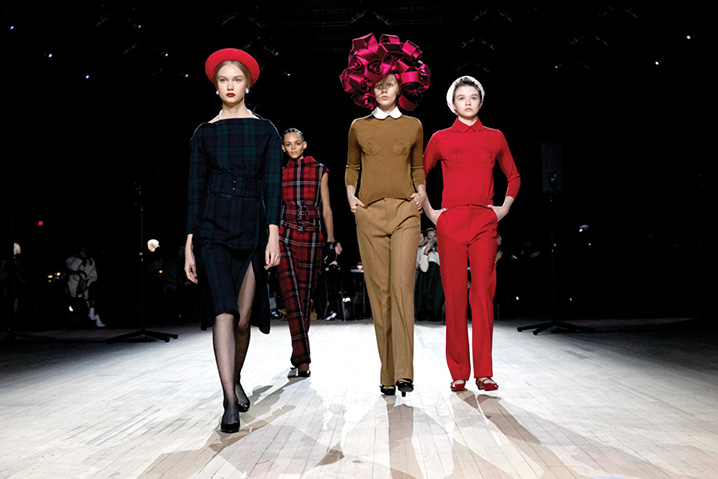NEW YORK: With the last show on the last day of the New York collections, Marc Jacobs finally gave shape to what fashion — and everyone else, for that matter — had been missing. He gave it heart and history; elegy and urgency. He gave it a ley line that connected Karole Armitage, “the punk ballerina,” who choreographed part of the show and lent it her dancers, to Miley Cyrus, the punk former Disney star, who modeled.
Most of all, he gave it scale.
There were more than 50 dancers running amok in the vast Park Avenue Armory, where small wooden bistro tables had been sparingly arrayed like the stage set for a Depression-era cabaret. More than 50 men and women — dressed in 1950s starlet pink bra-and-big pants combos, silvery shift dresses, Easter egg pastel sweaters, white lab coats and pumps — writhing and collapsing, pulled in one direction, then another; moving in sync and then moving against the tide.
More than 80 models, streaming forth, in uptown cashmere car coats and matching day dresses; slouchy trousers and crew necks with cone bras built in, often with Peter Pan-collar shirts beneath; glistening gray culotte suits and camel peacoats. Also cotillion dresses in silver and emerald green and evening gowns encrusted in three-dimensional metallic blooms.
The wardrobe of a city that once was, filling skyscraper boardrooms and ballrooms, typist pools and art collectives, and may never be again. The clothes of the dream that was New York. In the end, the models stood frozen like a very glamorous perp line and the dancers swarmed the audience, contorting their way among the tables in movements that toggled between ecstasy and horror. Arms and legs were everywhere. That’s kind of where we are now. But rarely has chaos looked so good.
There’s a tendency at the moment to look around and despair, on both the macro and micro scale. There’s a lot of helpless shrugging going on. Jacobs took that confusion and recast it. Not in a kinder, gentler light, or as a fantasy, but as a source of memory and creation.
The effort could easily have come off as bloated and self-important, except the clothes were so perfectly restrained. For a long time Jacobs held his show early in New York Fashion Week, until he decided he should have the last word. That’s a lot of responsibility to award … oneself.
Yet while his dreams of being a globe-straddling public brand may have shrunk — he has only five stores, down from 250 in 2013 — his dreams of using fashion to crystallize a shared moment are still monumental.
Thank goodness. Lately it seems as if he’s the only one who still believes this is possible. The big brands with the big dreams of giving form to our myths rather than making pretty dresses and dada sneakers are gone from the city. The last one to challenge Jacobs was Calvin Klein under Raf Simons, and that ended a little more than a year ago.
The newer names with force and vision keep scooting off in different directions, following their own noses. If this show demonstrated anything, it was that the live experience of a collection can still trump a short film or social media any day.
It has been an awfully minor New York. Not just because many designers are off the schedule or out of the city, though many are both, but because the ones who showed displayed such tiny, tiny ambition. So much so that everybody started to talk themselves into thinking small was actually the wave of the future. The intimate show; the personal garment — this was a good thing! Life was so crazy and huge right now that designers were just acknowledging they knew their place. Smart, really. Right?
As if. In 10 minutes or so of perfectly calibrated mayhem, Jacobs exposed the flimsiness of that idea.
This isn’t a city that was built on baby steps or obsessions with politely recasting the past. It was built on crazy risks and failures; earthquakes of imagination and buildings that reach ever upward. That’s part of why New York Fashion Week exists. It’s not just about the garment district. It is a metaphor for possibility far beyond its own borders.
Fashion — and the people who wear it — can rise to that heritage or hide in its shadow.
© 2019 The New York Times
Marc Jacobs and the Monumental Dream of New York
- Advertisement -

